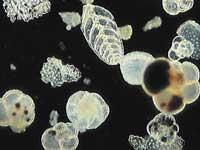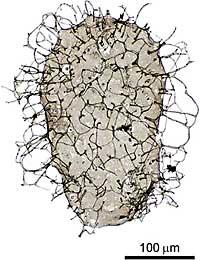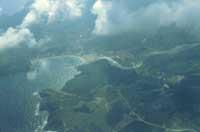Climate changes saved in microfossils
2004/03/01 Andonegi Beristain, Garazi - Elhuyar Zientziaren Komunikazioa Iturria: Elhuyar aldizkaria
Finding fossils of marine beings in the mountains of Euskal Herria is no wonder. In fact, formerly Euskal Herria was underwater, for example, in Paleocene, 65-55 million years ago. The Basque Country was subtropical and looked like the Australian coral wall.
Today, on the coast of Biscay and Gipuzkoa, in the area of Eibar, Irati and Urbasa, the rocks of the Paleocene abound in surface. In fact, the clash between the European plate and the Iberian plate caused what was then under the sea to rise. This shock also caused the Pyrenees.
These outcrops are not very common in the world, so researchers have unbeatable information about what happened in the Paleocene in the Basque Country. Another differentiating element is the presence in the Basque Country of deep sea rocks, platform and edge of the platform, since at that time Zumaia was in the seabed, while the Rioja Alavesa is in surface.

Planktonic foraminifers. (Photo: Microscopy UK).
In these rocks abound the remains that give us an account of the paleoclimatic and paleoecological changes of the time, such as microphosilas. The data obtained can be of great utility to predict the possible warming that is currently taking place. In fact, at the end of the Paleocene, as it happens now, the weather warmed up very quickly.
Microfossils: data warehouse
A group of researchers from Leioa particularly analyses planktonic foraminifers and lime nanofosicles that lived on the surface of the deep seas. In fact, these microfossils accumulated continuously for millions of years in the deep sea, forming a unique record.
These beings are very sensitive to climate and temperature changes. In fact, these microbicides are distributed in marine regions, some in cold waters and others in warm waters. Therefore, if the sea temperature rises, the regions change and with them the microbicides move. In this way, the registration of microfossils in a given place informs of the warming and cooling of the climate.
These microfossils, known today as components of rocks, are usually extracted from marl or limestone. For example, 80% of the limestone formed in the deep seas of Paleocene can be formed by these microfossils, that is, by microbicide shells.
To study this material, researchers must take a piece of limestone and divide it into the water. In a single drop of this mixture there can be millions of microfossils. These drops are then analyzed under a microscope or through the magnifier, since the fossils usually have a few microns in size.
In these studies, among other things, the species and the proportion in which they appear are counted. In particular, over 200 species of lime nanophosile and 175 planktonic foraminifers have been identified in the rocks of the Basque Country. Knowing what are the cold or hot water changes that have occurred can be known. And that data can be a lesson for the future.
- Project title Biological evolution and environmental changes in marine (sub)tropical areas of the Western Pyrenees of the lower Paleocene.
- Objective Through different micropaleontological groups and the statigraphy of sequences, to determine the biological evolution and changes of the environment in the marine (sub)tropical media of the Western Pyrenees of Paleocene.
- Director Xabier Orue-Etxebarria Urkiza.
- Working Equipment X. Orue-Etxebarria, V. Pujalte, E. Apellaniz, J.I. Baceta, A. Payros, G. Bernaola, F. Gentleman.
- Departamento de Estatigrafía y Paleontología.
- • Faculty of Science and Technology (Leioa)
- • • • • • • • • •

Gai honi buruzko eduki gehiago
Elhuyarrek garatutako teknologia





